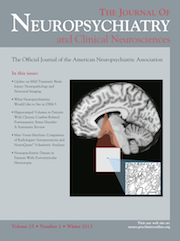Paranoid Personality Disorder and Organic Brain Injury: A Case Report
To the Editor: Paranoid personality disorder (PPD) is a mental disorder characterized by, for example, excessive sensitivity, self-reference, suspiciousness, and jealousy, which is included in both DSM-IV-TR and ICD-10 with relatively similar trait-concept definitions.1 There is a lack of clinical reports describing the presentation of PPD in connection with organic brain involvement. Here below, a retrospective case description is provided in which a patient presented with a history of head trauma, alcoholism, and the full-blown syndrome of PPD.
Case Report
A 46-year-old male blue-collar worker was first admitted to the psychiatric hospital after attempted suicide. In his teenage years, he had been hospitalized for head trauma with brain concussion after a traffic accident. Also, he had long-standing alcohol abuse. After detoxification, he was described as vulnerable, self-insecure, self-referent, very sensitive, touchy, suspicious, and mistrustful. The most prominent trait, however, was jealousy, especially in regard to his wife’s fidelity. Repeatedly, she was accused of miscellaneous matters and “interrogated” about diverse idiosyncratic issues. Alcohol intake consistently resulted in a marked accentuation of the paranoid pattern. During 3 inpatient admissions and 22 outpatient sessions, recurrent depressive symptoms were observed. However, no episode of clear-cut delusion formation was ever registered. No further cognitive impairments could be established, and so no brain imaging was performed. The patient had taken a variety of antidepressants, antipsychotics, and disulfiram, although, at last discharge, diagnosed with “paranoid personality disorder” and “episodic alcoholism,” there was no major clinical change.
Comment
The presented case suggests an association between organic cerebral factors and developing extensive features of PPD. Although the causal mechanisms cannot be fully clarified, it is plausible that the alcohol abuse and perhaps the brain trauma might have contributed to the presentation of PPD.
The available literature has been ambiguous with regard to the connection between organic brain factors and simple paranoid disorders in terms of pathophysiologic mechanisms and manifestations. Thus, for instance, Fils and Stewart recently demonstrated left-hemisphere injury in a case of Capgras syndrome (“delusion of doubles”),2 whereas a previously published study rather pointed toward right frontal brain injury in a patient with delusional jealousy, depression, and attempted suicide.3 Clinically, however, the possibility of extreme personality traits after alcohol abuse is acknowledged in the literature,4 and, likewise, traumatic brain injury is known to sometimes cause depression, suicidality, and personality changes with, for example, aggressive proclivities.5 Hence, even though the exact neurobiological correlates remain unclear, the possibility of an underlying substance abuse and organic brain injury should be considered in patients presenting with signs of PPD, and perhaps in pathological jealousy, in particular.
1 : Cross-system concordance of personality disorder diagnoses of DSM-IV and diagnostic criteria for research of ICD-10. J Pers Disord 2002; 16:283–292Crossref, Medline, Google Scholar
2 : Capgras syndrome related to left-hemisphere injury. J Neuropsychiatry Clin Neurosci 2011; 23:E6Link, Google Scholar
3 : Neuroimaging correlates of chronic delusional jealousy after right cerebral infarction. J Neuropsychiatry Clin Neurosci 2008; 20:245–247Link, Google Scholar
4 : A validity study of axis II of DSM-III. Am J Psychiatry 1985; 142:553–558Crossref, Medline, Google Scholar
5 : Neurobehavioral sequelae of traumatic brain injury. Mt Sinai J Med 2009; 76:163–172Crossref, Medline, Google Scholar



